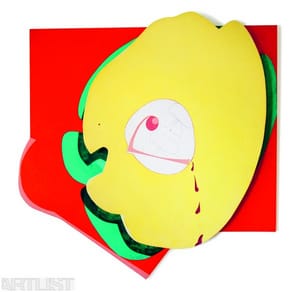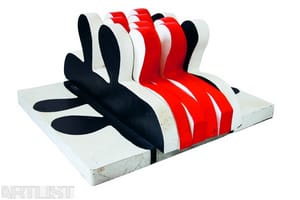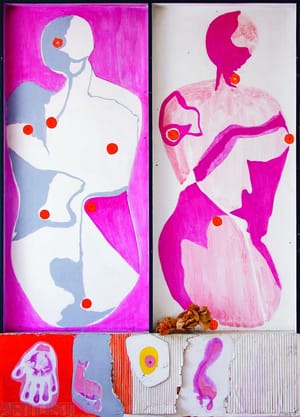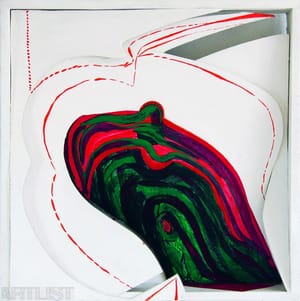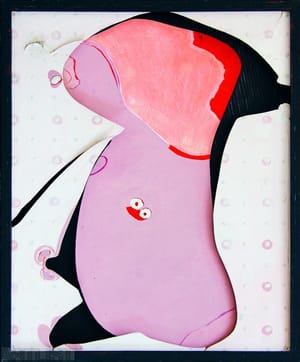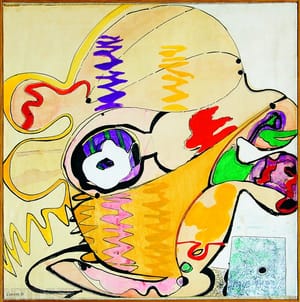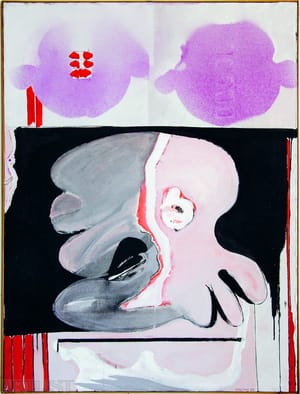- First Name
- Rudolf
- Surname
- Volráb
- Born
- 1933
- Birth place
- Košice, Slovak Republic
- Died
- 1969
- CSU Library
- ↳ Find in the catalogue
About artist
The pictures and objects of Rudolf Volráb capture important features of Czech art of the sixties. With the gradual arrival of exhibition possibilities, which only lasted a few years and almost symbolically ended with Volráb’s death in 1969, the Czech exhibition space slowly opened up both to foreign exhibitions and exhibitions of Czech artists abroad, including their personal participation. Czech art of that time had the ambition of equalling and being included amongst the broad spectrum of world art, an ambition supported by critics such as Jindřich Chalupecký, Jiří Padrta, František Šmejkal and others, as well as offering Czech art the chance to draw on global trends.
After completing his education in 1961 Volráb’s work opened up to the possibilities of Art Informel, a tendency deepened by his friendship with Z. Beran, J. Valenta and A. Tomalík. Even these connections served to make manifest Volráb’s distinctive and characteristic creative interest. The artist was attracted not only by the grating existential character of informel, but far more by its radically new visual possibilities. The picture is liberated from narrative and manifests itself mainly by means of the language of its resources – sediments of paint and interventions in them using incisions, for instance, release them and deepen the expressive possibilities of paint and its structure. Even in this abstract phase of creation Volráb’s lifelong theme begins to make an appearance, which was the figure, not so much for its story and meanings and symbols, but more as a figure thematising the pictorial surface, its composition, erosion and fragmentation, which gradually leads to the disruption and opening of the pictorial surface. However, the figural visual structure retains a strong emotional attachment with the world, which deepens this structure by means of strong sensuousness, experience of the body, physicality as a network through which the artist appropriates the world. This physicality often has expressive erotic connotations.
These traits often see Volráb’s work assigned to new figuration, while his beginnings are associated with informel, creating a broad period framework and allowing for the conceptual display of the confrontation of artists for whom both lines determined his creative output. However, privileged theme of the figure took many different forms and often completely different starting points. Their confrontation at an exhibition of new figuration in Prague in 1969 allowed strong individuals and their different attitudes to the human figure to come to the fore as it used to be at the time of the existential works of K. Nepraš, J. Balcar or otherwise in the case of J. Načeradský, A. Kučerová and A. Šimotová and others, or O. Slavík, whose work was characterised by the same sensuousness and physicality as in the case of Volráb.
The overriding trait of Volráb’s work remains its spontaneous analytic quality, which led him to experiment with the surface of the picture through disturbance, decomposition and fragmentation. Around 1967 he created pictures or paintings (more precisely work on paper which alternates between painterly procedures in a different medium) which comprise various surfaces and forms creating an irregular formation, sometimes supplemented by other materials, such as in the picture Four, painted in 1969, in which a developed shape in four metamorphoses is finally transferred into a plastic sculpture. A similar procedure is underway with the figure dismantled into fragments, which is recomposed into new structural relations. At the same time the picture begins to open into space, it is constructed by means of coloured layers of various shapes which transform the painting basically into an object. However, it remains a painting which develops from the surface and simply opens up space by means of its levels.
However, another important period pictures which connected Czech art to global tendencies needs to be mentioned. Volráb’s work is assigned the label new figuration, but as in the case of Jiří Balcar in terms of its expressiveness and discourse it is close to pop art. It is clear in the artistic procedure which links fragments or parts of the body with their whole, the alternation of which is reminiscent of a printed surface. Volráb’s method of working with the basic tones of colour and in using mainly direct colours.
In 1968 and 1969 the Artchemo symposium was held in Pardubice, which was focussed on the utilisation of artificial substances in art. Volráb participated in the form of objects which were based on his previous gradual opening of the surface of the picture into space. In layered and overlapping transparent plastic silhouettes the picture was transformed into a spatial structure, and object. Whether this method indicated another path via object to sculpture we cannot understandably say. However, it is possible that this was the influence of Volráb’s beginnings in the glass studio in Kamenický Šenov, and there is a connection with the focus of the Josef Kaplický studio at Prague’s Museum of Decorative Arts on glass production. Volráb’s fellow students here included V. Kopecký, S. Libenský and D. Vachtová. Rudolf Volráb was an initiating personality who exceeded the boundaries between individual creative spheres and created his own theme through their intersection of their procedures.
- Author of the annotation
- Jan Rous
- Published
- 2010
CV
1952-1961 /2 years in military service/ studied at School of Art, Architecture and Design ( VŠUP), Prague, Josef Kaplický´s studio
Exhibitions
- Solo exhibitions
-
2010
Topičův salon, Praha
2002
Galerie moderního umění, Roudnice nad Labem
1985
Národní dům na Vinohradech, Praha
1961
Divadlo E. F. Buriana (společně s J. Hendrychem), Praha
- Group exhibitions not included in ARTLIST.
-
(selection)
1993-94
Nová figurace /putovní výstava/, Litoměřice, Pardubice, Brno, Opava, Jihlava
1969
Artchemo, Pardubice
Nová figurace, Praha
1968
Danuvius Bratislava
1966
Jarní výstava, Mánes, Praha
Monography
- Monography
2010 kat. výstavy Topičův salon Praha /J. Rous/
2002 kat. výstavy Galerie moderního umění Roudnice nad Labem /M. Hlaváčková/
1997 M. Nešlehová, Poselství jiného výrazu, ARTetFAKT Praha
1995 Nová encyklopedie českého výtvarného umění, Academia Praha
1985 kat. výstavy v Národním domě na Vinohradech /M. Pánková/
1970 L. Novák, Nová figurace, Obelisk, Praha
1969 Výtvarná práce č. 14-15, Nová figurace
1968 R.V., Výtvarné umění č.5, 6
1967 R.V., Výtvarné umění č. 10, Z. Felix
1967 R.V., Literární noviny, 29. 7.
